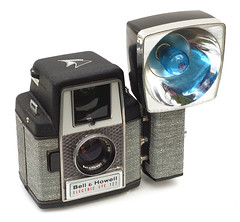Difference between revisions of "Bell & Howell Electric Eye 127"
m (→Electric Eye: CW pool membership) |
John Kratz (talk | contribs) m (adjusted image rights) |
||
| Line 35: | Line 35: | ||
|image_text= Black and tweed version<br>with matching accessory flash | |image_text= Black and tweed version<br>with matching accessory flash | ||
|image_by= John Kratz | |image_by= John Kratz | ||
| − | |image_rights= | + | |image_rights= non-commercial |
}} | }} | ||
{{Flickr_image | {{Flickr_image | ||
Revision as of 12:59, 13 October 2011

|
| Bell & Howell Electric Eye 127 image by Voxphoto (Image rights) |
The Electric Eye 127 was introduced in 1958 by Bell & Howell. Although better known for producing movie cameras, Bell & Howell found success with the Electric Eye 127.
The 1938 Kodak Super Six-20 was the first camera to offer photocell-controlled autoexposure, but fewer than 730 were ever sold. Bell & Howell's Electric Eye 127 brought autoexposure to the popular snapshooter market, in a whimsically-styled cast-metal body.
A selenium photocell adjusted the two-bladed diaphragm in response to the scene brightness. The auto exposure provided by the selenium cell can be overridden by opening the small door below the lens and moving the slide adjuster. Twelve 4x4cm exposures could be taken per roll of 127 rollfilm.
The Electric Eye was offered in two finishes: black leatherette on a silver body, or tweed on a black body. There is also limited information to support the idea that the Electric Eye was offered with two different lenses. More research needs to made before this can be confirmed.
Electric Eye
- Manufacture: Bell & Howell
- Country: USA
- Year: 1958-1959
- Body Type: Cast Metal
- Film Type: 127 roll
- Lens: Wide View Special ??mm
- Shutter Type: Rotary
- Aperture Type: Blade

|
| Black and tweed version with matching accessory flash image by John Kratz (Image rights) |

|
| Bell & Howell Electric Eye image by Ryan R Warner (Image rights) |

|
| Bell & Howell Electric Eye and Case image by Ryan R Warner (Image rights) |
Links
- "New Electric-Eye Camera Takes Foolproof Snaps" with an explanation of the metering system, Popular Science magazine, February 1959, pg.152-153, at Google Books
- More views of the tweed version at www.westfordcomp.com